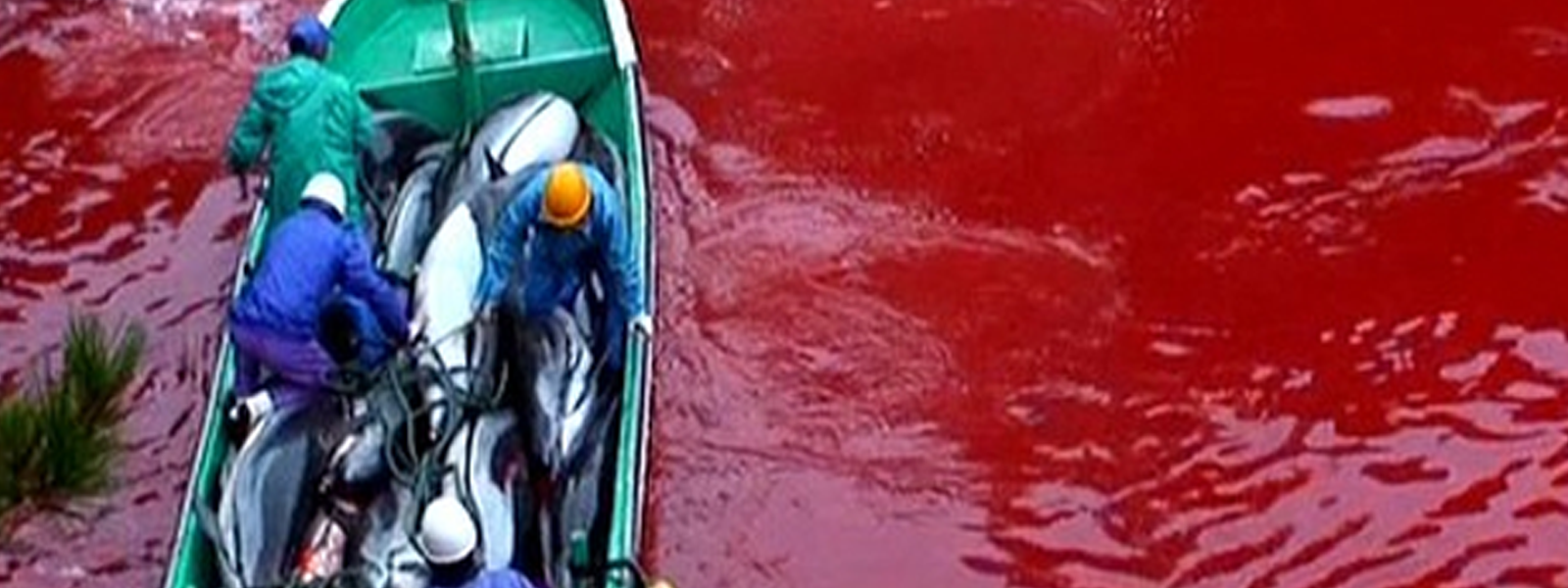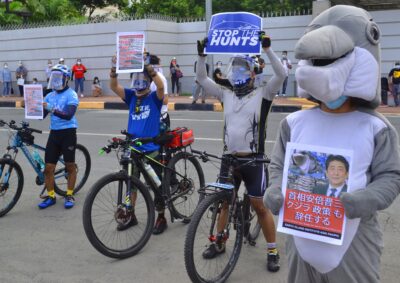

On September 1st, the Taiji dolphin hunters once again opened the annual dolphin-hunting season, with the banger boats heading out to the ocean daily for the next six months. Four bottlenose dolphins were captured on the first day of the season, all of which were put in slings and carried off to the Taiji Whale Museum for a lifetime of small tanks and eating dead fish.
When they succeed in finding a dolphin pod, the hunters will herd the dolphins into the notorious Cove by use of poles stuck into the water and banged on by hammers, producing a wall of sound. The frightened dolphins in the Cove are then surrounded by nets, where representatives of captive dolphin facilities and international dolphin brokers will choose a few to grab for a lifetime of captivity.
The rest – females, males and calves – are usually slaughtered in a welter of blood.
Occasionally, the hunters will herd some of the dolphins back to the ocean, where the traumatized individuals face a hard recovery and are unlikely to survive. This often happens with “surplus” bottlenose dolphins, which are more highly prized for captivity than other species and are showing signs of depletion due to the Taiji killings.
According to CetaBase, the quotas issued by the Japanese government for the 2020-21 hunt season are the same as last season’s numbers.
These include 1,749 individual dolphins of nine different species:
100 Pacific white-sided dolphins
450 striped dolphins
298 bottlenose dolphins
280 Pantropical spotted dolphins
251 Risso’s dolphins
101 short-finned pilot whales
49 false killer whales
20 rough-toothed dolphins
200 melon-headed whales
As in the past, it is unlikely that the hunters will catch anywhere near the full quotas, which makes the quotas useless for conservation purposes.
For example, the Taiji 2018-19 season quota was for 2,047 dolphins total, but only 534 dolphins were slaughtered along with eleven dolphins that died during the captures and 241 that were removed for captivity (which counts against the quota), for a total 786, only 38.4% of the quota.
While dolphin meat consumption has declined since the International Marine Mammal Project (IMMP) of Earth Island Institute began our Save Japan Dolphins Campaign in 2004, the hunts have switched to concentrate on catching live dolphins for captivity, which is far more lucrative than the meat market. Dolphin deaths have declined by more than 60% since 2004, but live captures for captivity have more than doubled in some years.
China remains the largest market for captive dolphins, although Japan itself has around one hundred dolphinariums, ranging from large SeaWorld-like aquariums to small, netted pools in harbors where one can “interact” with a live dolphin for a hefty fee.
Japanese activists have continued to step up their protests against the Taiji Whale Museum (hub of the captive industry in Taiji) and other places, objecting, like their activist friends in other countries, to keeping intelligent and social dolphins in small concrete tanks, having to do tricks in order to be fed each day.

The Earth Island Asian Pacific Office sponsored a protest in the Philippines against the Taiji dolphin hunts. This is the 15th year our office has demonstrated against the hunts.
So far, the town of Taiji and the Japan government have resisted all attempts to curtail the dolphin drive hunts, despite worldwide protests from Japanese and animal activists and conservationists outside the country.
Banner Photo of Taiji Dolphin Hunt copyright Oceanic Preservation Society.